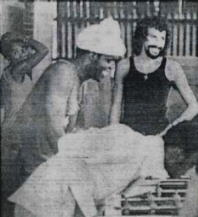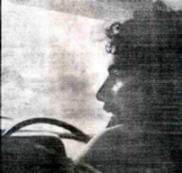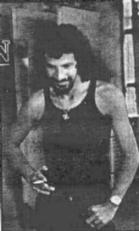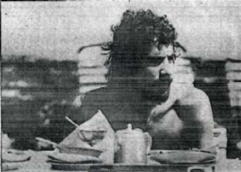Another wonderful article presented to Majicat by Linda
Crafar. This rather entertaining article takes us into the studios of
Jamaica during the recording of Foreigner Suite.Unfortunately the quality of the
pictures from this article isn't the best, because they come to us via b&w
photocopies. But still worthy of being in the scrapbook.
- Cat Stevens - The Making of
Foreigner Suite
- New Music Express
- March 10, 1973
- Courtesy of Linda Crafar
Cat Under A Hot Tin
Roof
Roy Carr
reports on a sweltering studio session with Cat Stevens in Jamaica
 Having convinced an obliging yet highly suspicious pistol-packin’
uniformed security guard that in no way am I an unwelcome intruder, I pass through a heavy
iron gate and slowly shuffle down the wide dusty gravel path that leads to the squat
flat-topped buildings that house the much-in-demand recording studios of Dynamic Sound. Having convinced an obliging yet highly suspicious pistol-packin’
uniformed security guard that in no way am I an unwelcome intruder, I pass through a heavy
iron gate and slowly shuffle down the wide dusty gravel path that leads to the squat
flat-topped buildings that house the much-in-demand recording studios of Dynamic Sound.
It’s just a few short
hours since I fled the arctic conditions of New York City, and now the intense tropical
heat of Kingston Jamaica, makes any movement strength sapping. I saunter past a bunch of
local musicians and studio technicians noisily bashing the daylights out of a large
football machine (courtesy of Elton John), and a voice suddenly enquires of me. "Eh
mahn . . ah you whid daht mahn Cart Stevuns?"
I turn to acknowledge the
fact, raising my right hand to protect my eyes from the blinding glare of the noonday sun
—and focus on a grinning ebony face almost hidden beneath the largest knitted hat
that I’ve ever seen.
"That mahn . . .
he’s-a mahd." drawls the thick brogue from between large ivory white teeth.
"That ras, he never cum out. He’s-a in daht stoo-dio dayh ahn night since he
been ‘ere. Tell me mahn, why don’t he cum out ahn ‘ave sun fun?"
I smile nervously,
shrugging my shoulders, and wipe the beads of perspiration from my brow. For some unknown
reason I feel embarrassed, as if it were my fault. Knitted-head laughs. Then I step out of
the heat and into the cool dimly lit atmosphere of a small tiled foyer leading to two
studios.
To my left, the bass-heavy
rhythms of reggae vibrate the skins of a bright red drum kit stacked against the wail.
Immediately in front of me, the familiar sound of Cat Stevens’ husky voice penetrates
the playback speakers and filters along a darkened padded corridor. The contrast is stark.
This then must be the place.
Today is Monday and Cat
Stevens has almost completed two weeks of his three-week recording schedule in Kingston.
Except for yesterday, when friends almost physically forced him to relax, go sailing,
swimming and shark fishing in the bay, Stevens — along with his sound engineer John
Middleton has been incarcerating himself in the air-conditioned studio on an average of 14
hours each day.
Despite such exhausting
sessions, Stevens is remarkably alert, fresh and most important of all, enthusiastic.
"I like recording to
be heavy sweat, he confesses while working out the technical requirements for this
afternoon’s session. That’s when things really work."
Middleton sets the
controls, looks up from his console, and with a sharp nod of his head agrees with that
statement. In a few minutes, Stevens intends to entirely re-record "Sunny Side
Road" with the assistance of Gerry Conway —his lobster red drummer — and
Jean Rousseau, who, aside from playing keyboards will score the brass and string
arrangements to be added at a later date.
A few days earlier, Stevens
had laid down this and other tracks for this new album with an illustrious trio of New
York’s near-legendary super sessioners, who jetted in from the Big Apple to add grits
n’ greens to what this troubadour considers to be his soul album.
And soul don’t mean,
umpteen choruses of "In The Midnight Hour" and hollering "Good Gawd
Y’AlI . . . Mercy, Mercy. Mercy."
Phil Upchurch just picks
out super-slick guitar licks; Paul Martinez blows out stereo speakers with quicksilver
bass bops; and Bernard "Pretty" Purdie is outrageously confident as he
consolidates his reputation as his country’s leading studio drummer.
"You’ve really
gotta be on your toes when you’re in a studio with those guys." says Stevens,
who is still concentrating on the production chores. But the reason why I used these three
guys was very simple. I like ‘em. Anyway, I’ve been listening to a lot of black
music. I mean, deep down inside, everyone’s got a lot of black. It’s up to the
individual just how much he lets it show."
One reason why Cat Stevens
chose to record this batch of songs in Jamaica shows in the following statement.
"To be quite
frank." he begins, "more often than not I feel far more relaxed with coloured
people."
The people in the control
booth stop what they’re doing to listen. Stevens continues:
"This is a good
album,"— he gestures towards a pile of tape boxes stacked at the far end of the
console — "and completely live. In no way could I have made this album in
London."
He dismisses suggestions
that it’s just chic one-upmanship to put "Made In Jamaica" on the sleeve.
"There’s no
distraction whatsoever in this place," he points out. "No phones or people
wanting to meet you tomorrow for this, that and a hundred and one other things. In this
place everything’s done purely on a day-to-day work basis. You come in the studio
feeling good and you get a good track down. If you don’t feel like that then you
don’t get a good track down. But the great thing is that there aren’t any
distracting pressures. This album is the quickest one I’ve ever recorded. You’ll
feel it after you’ve been here a couple of days — the atmosphere around this
place is very alive and after a while it just rubs off on you."
 The decision to completely re-record this song from scratch, gives some
insight as to the spontaneity of the sessions Stevens is hosting at Dynamic Sounds. Being
exposed to the infectious quality of the local music has subconsciously influenced the
man, not to emulate, but to interpret the feeling that abounds throughout the island. The
result is he believes he has now come up with a far better arrangement. The decision to completely re-record this song from scratch, gives some
insight as to the spontaneity of the sessions Stevens is hosting at Dynamic Sounds. Being
exposed to the infectious quality of the local music has subconsciously influenced the
man, not to emulate, but to interpret the feeling that abounds throughout the island. The
result is he believes he has now come up with a far better arrangement.
"I've noticed that
here there's hardly any aggression in the music," he observes. "Even when they
protest you can’t help but smile a bit, because you know they’re putting it on.
Even though they’ve got a few hang-ups, basically most of the people are happy. They
rarely let things get them down."
Stevens wanders into the
studio and sits down in front of the keyboard of an ARP synthesiser. After trying a few
effects he states. ‘"Sunny Side Road’ is a key track and therefore has to
be good." He slips a pair of cans over his ears and adds:
"But then so have all
the other tracks."
Stevens lays down the first
basic track on his keyboard, then as the hours slowly and at times laboriously tick by
'Sunny Side Road’ starts to take on some semblance of shape.
Gerry is called away from a
game of table football to add a drum part and likewise Jean dons a pair of
‘cans’ and pumps out a nifty bass figure on the re-programmed ARP.
After a mysterious lady has
wandered unto the control room and informed the assemblage that "Engelbert
Humperdinck is my boy," all three musicians gather round a solitary microphone to
thrash out a complexity of percussion sounds. A playback is called for. The unanimous
decision is that everything sounds un-together. They begin all over again from square one.
By early evening, the arduous process of elimination has resulted in number taking on an
entirely different aspect. Things are much better when Cat’s
'Man-For-All-Seasons’ Carl Miller arrives with canisters of delicious hot Chinese
food. Within minutes everything is devoured and both Cat and Jean busy themselves with
putting on over-dubs.
Around 2 am a halt is
called for and everyone drives back to the Terra Nova Hotel and some much-needed sleep. By
noon the following day, everyone is back in the studio and still working vigourously on
the same song. Stevens is back at the keyboard, but this time singing as well as playing.
Take after take is recorded, but none to his satisfaction. John Middleton is starting to
look fatigued when suddenly, the door to the control booth is flung open and in dashes
Stevens yelling.
"I really got off on
that one. Play that one back -to me."
Middleton rewinds the tape,
presses a button, and everything comes blaring out of the bank of playback speakers.
"Great . . . this is
how I flrst heard it," shouts the singer as he jumps up and down in time to the
music. His black sweat-soaked hair brushing his recently bronzed shoulders.
"D'ya like that
one." he enquires of CarI.
"Yeah." replies
the expectant Father
"That's the one . .
you know it when you’ve done it. Let s hear it again John."
An instant action replay
confirms Stevens initial outburst.
"I love it," he
yells.
"You look like a Cat
that’s just woken up." mumbles a weary sound engineer.
"All we need now is
for Gerry to put on another drum track and it’s completed."
At this statement from
Stevens the drummer rolls his eves heavenwards and slinks off back into the studio. At 1am
the session is wrapped up. It s noon of the following day, Cat, Carl and I are sat by the
hotel swimming pool having a late breakfast.
"Don t you get tired
of working on one track for so long," I enquired, for it will take yet another full
day for the various aspects of "Sunny Side Road" to be completed.
"Never," is his
prompt reply. "I never get beat. At the moment, I feel that I'm on my third
life."
He proceeds to clarify that
remark.
"My first was with 'I
Love My Dog’ and "Matthew And Son’, the other was the first three albums I
did with Island with ‘Catch BuIl At Four' acting as the bridge to my third. Those
first three albums I did for Island were very nice and very chummy," he reflects,
"but I don’t want to come up with albums that are safe and predictable. I can
only think of what's happening now. Before coming here to make this album, I made up my
mind that from now on I’m not going to plan anything. And as such, any future tours
will only be agreed upon just a month in advance, in that way it will create the kind of
energy rush and storm that I want.
Later as we drove through
the city of Kingston towards the studio, he continues.
"There’s a
feeling of pure love about this album. At the moment I happen to have a very nice thing
going. Perhaps it’s my stars," he offers. "I don’t really know, but
whatever it is, it's very conducive to what even it is I’m doing. It seems nothing
can turn me over or upset me and I’m going to make sure that nothing does."
We drive past the security
guard, down the gravel path and bring the car to a halt right alongside the football game,
which is surrounded by a dozen or so guys. Knitted Hat is there, smiling as usual. He
looks at Cat Stevens as he disappears into the studio.
"He’s-a mahd man,
he spends three days on one song," he says as he bangs home a goal.
I’ve heard the music and l’d
argue the fact.
|